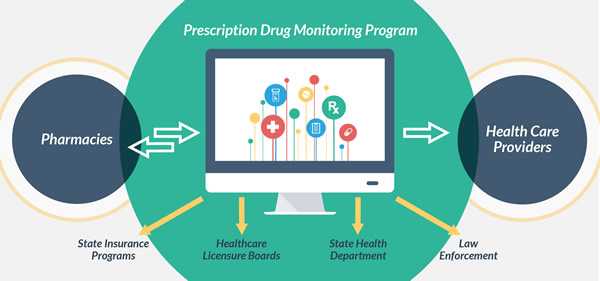What States Need to Know about PDMPs
Prescription drug monitoring programs (PDMPs) continue to be among the most promising state-level interventions to improve opioid prescribing, inform clinical practice, and protect patients at risk. Although findings are mixed, evaluations of PDMPs have illustrated changes in prescribing behaviors, use of multiple providers by patients, and decreased substance abuse treatment admissions. States have implemented a range of ways to make PDMPs easier to use and access, and these changes have significant potential for ensuring that the utility and promise of PDMPs are realized.
What is a PDMP?
A prescription drug monitoring program (PDMP) is an electronic database that tracks controlled substance prescriptions in a state. PDMPs can provide health authorities timely information about prescribing and patient behaviors that contribute to the epidemic and facilitate a nimble and targeted response.

Promising PDMP features include:
-
Universal Use
PDMPs are promising tools for health care providers to see patients’ prescribing histories to inform their prescribing decisions. However, a PDMP is only useful to health care providers if they check the system before prescribing. Some states have implemented polices that require providers to check a state PDMP prior to prescribing certain controlled substances and in certain circumstances, and these policies have significant potential for ensuring that the utility and promise of PDMPs are maximized. -
Real-Time
When pharmacists dispense controlled substances to patients, they have to enter the prescription into the state PDMP. However, pharmacies submit this data to state PDMPs at varying intervals—ranging from monthly to daily or even in “real-time,” i.e., under five minutes. If there is a long interval between dispensing and submission into the state PDMP, providers and other PDMP users will not have information on patients’ most recent prescriptions. Timely data, like in a “real-time” PDMP, maximizes the utility of the prescription history data, with significant implications for patient safety and public health. -
Actively Managed
PDMPs are more than just passive databases. As a public health tool, PDMPs can be used by state health departments to understand the behavior of the epidemic and inform and evaluate interventions. PDMPs can also be used to send “proactive” reports to authorized users to protect patients at the highest risk and identify inappropriate prescribing trends. -
Easy to Use and Access
States have taken a number of steps to make PDMPs easier to use and access. Promising practices include integrating PDMPs into electronic health record (EHR) systems, permitting physicians to delegate PDMP access to other allied health professionals in their office (e.g., physician assistants and nurse practitioners), and streamlining the process for providers to register with the PDMP.
Continued state-level evaluation of PDMPs can lead to greater identification and implementation of promising practices.
- Page last reviewed: October 3, 2017
- Page last updated: October 3, 2017
- Content source:
- Centers for Disease Control and Prevention,
- National Center for Injury Prevention and Control,
- Division of Unintentional Injury Prevention


 ShareCompartir
ShareCompartir
